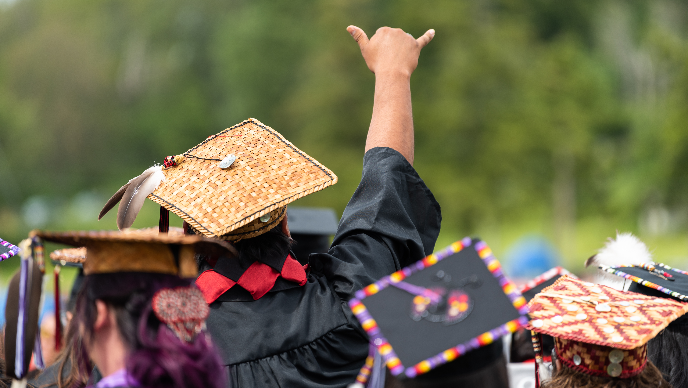Tribal Colleges and Universities in the United States: What They Are, Who They Serve, and Why They Matter

Photo courtesy of Northwest Indian College
Every year, millions of students enroll in colleges and universities across the country. Most often, Indigenous students make up a small percentage of their student body. However, many students opt to go to tribal colleges and universities, where the majority of students are Native American.
Before tribal colleges were established in 1968, Native American students had few options for a culturally relevant education. Most college efforts for American Indian students in decades past were focused on Christianizing or vocational training. When tribal colleges were developed in the late 1960s, tribes created schools to serve their students, with services that met the unique needs of their communities.
What Is a Tribal College?
Tribal colleges are schools that are owned and operated by Native American tribes in the U.S. There are 35 accredited tribal colleges in the United States, mostly located on or near reservations in the northern states and Southwest.
While most TCUs are community colleges where the majority of students earn associate degrees and certificates, 19 tribal colleges offer bachelor's degrees.
There are only a few four-year tribal colleges that award more bachelor's degrees than associate degrees: Haskell Indian Nations University in Kansas, the Institute of American Indian and Alaska Native Culture and Arts Development in New Mexico, and Sinte Gleska University in South Dakota.
Tribal colleges primarily serve American Indian and Alaska Native students, but students from other demographics can also attend. Most tribal colleges serve some students who are white, Black, Latinx, or another race.
TCUs receive limited funding from the federal government, but do not receive state funding like other public colleges do. They operate on a fairly limited budget,
Source: IPEDS
About the Data
Percentage of Students Who Are American Indian or Alaska Native
While American Indian and Alaska Native students tend to be underrepresented on many college campuses, tribal colleges primarily serve Native American students.
Nearly every tribal college serves a majority of American Indian and Alaska Native students. At non-tribal colleges, less than 1% of students are Native American.
Haskell Indian Nations University, Southwestern Indian Polytechnic Institute, and Stone Child College serve the highest rate of Native American students. Fond du Lac Tribal and Community College serves the lowest rate at 8%, and is the only tribal college where less than half of the student body is Native American.
Online Classes at Tribal Colleges
Many tribal colleges have quickly adapted to serve online communities, with 10 schools serving more than half of their students fully online in 2020-21. Another 10 colleges had at least half of students enrolled in both online and in-person programs for the same year. Nine TCUs reported no students enrolled in distance education classes for the 2020-21 school year.
Enrollment at Tribal Colleges
Tribal colleges tend to serve smaller student bodies, with enrollment ranging from 125 students at Red Lake Nation College to 1,975 students at Fond du Lac Tribal and Community College in the 2020-21 school year.
The top five largest tribal colleges by enrollment are below.
| School | Total enrollment (2020-21) |
|---|---|
| Fond du Lac Tribal and Community College | 1,975 |
| Navajo Technical University | 1,882 |
| Dine College | 1,872 |
| Oglala Lakota College | 1,626 |
| Tohono O'Odham Community College | 1,574 |
Source: IPEDS
Tribal colleges enroll few graduate students, if any. Only five colleges had graduate students in the 2020-21 school year.
| School | Graduate Enrollment (2020-21) |
|---|---|
| Sinte Gleska University | 155 |
| Oglala Lakota College | 48 |
| Institute of American Indian and Alaska Native Culture and Arts Development | 44 |
| Sitting Bull College | 28 |
| Navajo Technical University | 13 |
Source: IPEDS
Percentage of Undergraduate Students Receiving the Pell Grant
At least half of students at most tribal colleges receive the Pell Grant, which usually goes to students with family incomes of $60,000 or less per year. The tribal colleges with the most Pell students are Aaniiih Nakoda College in Montana, Leech Lake Tribal College in Minnesota, and Sitting Bull College in North Dakota. Four out of five undergraduate students at these colleges used the Pell Grant to pay for school in the 2019-20 school year.
Ilisagvik College in Alaska and Fond du Lac Tribal and Community College in Minnesota serve the lowest rate of Pell students, with less than 25% receiving the grant.
Retention Rates
Retention rates show how many students who enrolled in college the year before returned the next fall. They can help give a sense of how well students are doing and can serve as an early indicator of what graduation rates might look like down the road. Things like strong support services and quality programs help keep students enrolled and making good progress toward their degree.
Retention rates for tribal colleges varied widely in Fall 2020, ranging from 18% to 100%. The average retention rates for tribal colleges and non-tribal colleges were both about 69% for students returning in Fall 2020, meaning these schools had similar rates of students returning from the year before.
Top Programs at Tribal Colleges
The most popular majors for graduates of tribal colleges are business administration, liberal arts and sciences, general studies, and American Indian studies, based on IPEDS data for the graduating classes of 2021.
Native American Student Support at Tribal Colleges
Research from Gallup and the College Fund shows that tribal college graduates tend to get better support and have a better college experience than students from other schools.
So what are tribal colleges doing differently? Students at tribal colleges are more likely to say they had encouraging mentors, and professors who cared about them and made them excited to learn while in college. Many students also benefit from culturally relevant traditions and curriculums on campus.
Monica Little said an important aspect of her success is how family-oriented her campus is. She is a single parent with three kids, and she doesn't think she would have thrived at another college.
"When I decided to go back to college, I knew that I needed something that would cater to my needs," she said. "It's just not as easy to be as committed as other colleges asked. But instead of not being able to be committed at Northwest Indian College, it's family-friendly."
Little said students are encouraged to bring their families to student events and activities. She was also able to bring her kids with her to campus when she did volunteer hours and an internship over the summer. These accommodations help students succeed in school, alongside benefits like the option for virtual classes, peer tutoring, support programs for personal growth and life skills, 24/7 mental health services, and emergency funding.
Students at tribal colleges are more likely to say they had encouraging mentors, and professors who cared about them and made them excited to learn while in college.
Scholarships for Native American Students and Tribal Colleges
There are many grants, scholarships, and other funding sources available to help students at tribal colleges pay for school. One of the biggest sources of funding is federal aid, which students can apply for by filling out the FAFSA. This one application may help students get financial aid like the Pell Grant, state funding, and scholarships from their school.
Native American students can also apply for grants and scholarships from the Bureau of Indian Affairs:

